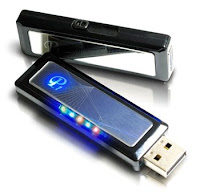 Did you know that you could get an entire operating system on a flash USB drive? Most firmware in modern PCs allows booting from these drives. That means that a bootable flash drive could allow you to launch an operating system, this is commonly called Live USB and applies mostly to Linux operating systems. However, there is a MS Windows version available and some versions of BSD are also available on flash USBs.
Did you know that you could get an entire operating system on a flash USB drive? Most firmware in modern PCs allows booting from these drives. That means that a bootable flash drive could allow you to launch an operating system, this is commonly called Live USB and applies mostly to Linux operating systems. However, there is a MS Windows version available and some versions of BSD are also available on flash USBs.Live USBs are good special purpose or brief tasks like doing an operating system install or disk cloning operation across a network, loading a minimal kernel for embedded operations and maintenance tasks.
A properly configured Windows USB flash drive will allow you to install a version of Windows XP on a drive, with extra software if there's space. To do this, a special utility is required, as well as a fairly large drive. You will end up with a portable, compact emergency version of your operating system.
Live USBs are more commonly used by Linux operating systems, and are closely related to the now-common live CDs. Like CDs, USBs can be used to help test a distribution, recover data and many other tasks. Live USBs have many of the same limitations and benefits of a live CD. It is, however, easier for a live USB's data to be changed, since CDs are usually permanently written. That makes it easier to use a live USB as personal storage, allowing a user to carry their preferred applications, operating system and configuration. Sharing a single system between multiple users is much easier in this case.
Live USBs can also provide extra privacy, since the USB device is carried by the user and storage in a safe location is easy. However, the small size of these devices also means that they are easily lost and stolen; making backups and encryption more important for USB flash drive operating systems than normal desktop operating systems.
Since USB drives have no moving parts, they are able to have a faster seek time than optical media and hard drives, this means small programs start faster from USB flash drives than from a live CD or hard disk. However, the low data transfer speeds of some USB devices can make booting from them very slow. In addition, older computers may not have a BIOS that supports booting from USB devices. Booting an operating system from a USB drive may slightly reduce the life of the flash drive.
Carrying your own personal operating system in your pocket can be extremely useful for travellers or people using shared computers. Some sites offer tutorials on simplified flash drive installation for many different distributions of Linux (which is the most popular OS for this purpose). These tutorials mean it is much easier to install, boot and run your preferred distribution, with all your settings and files, from a very small drive. Just be sure you have a large enough drive and that you are using it in a computer capable of booting from the USB port.
Note: USB 2.0 capability greatly speeds things up, as well.

0 comments:
Post a Comment